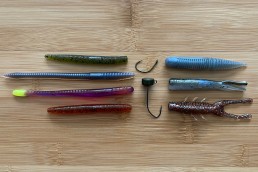Bottom Dead Sticking
SHARE THIS POST
If you’re looking to get some action going during this cold-water period, Dan Brozowski says give bottom dead sticking a chance.
Whether you use a wacky rig or Ned rig, both will perform in cold-water conditions.
If you’re one of those anglers who fishes with a rod in one hand and an energy drink in the other, this might not be the technique for you! I’ll have to admit, though I’m a patient angler, in the beginning I almost had to lay my rod on the bank to make this system a success. After a cast, most anglers’ natural instinct is to impart some type of action to the terminal end of your line to entice whatever lies below. Yet bottom dead sticking has none of that.
Technically, dead sticking is defined as the art of doing nothing, which for some activities sounds appealing. Yet for this angler, and especially those using artificial baits, there’s a polar opposite mindset to attracting a response from your target species. The technique of “dead sticking” a bait is not a new approach; it has been around for many years. But for the most part, it is primarily a retrieve used with hard baits, and quite often with a surface bait.
I used it many years ago when fishing the Original Rapala Floating Minnow. The technique is as simple as casting out your offering, letting it sit stationary on top, and then waiting to see who has the most patience—you or the fish eyeballing your bait from below. It certainly works. I’ve taken my share of smallies, largemouths and pike dead sticking the Rapala, but other baits work as well.
Bottom dead sticking, on the other hand, seemed a little extreme in theory to me. While a stationary bait on the surface has a very visible overhead profile for the fish, a bait lying motionless on the bottom seems that it would blend in unnoticed. So, let’s look at why this system works.
First, during the cold-water months, the bottom vegetation in many waters disappears, leaving the bottom free of growth that might swallow up and camouflage your offering during the warm-water, weedy periods. At this time of year, a dead sticked bait will appear obvious against the barren bottom backdrop.
In addition to the lack of vegetation, the water typically becomes much clearer during these cold-water periods, allowing fish to see your bait resting on the bottom. More importantly, in my opinion, fish can see your bait settling towards the bottom from a distance and follow it to its resting place, which is the key to this technique.
Are you enjoying this post?
You can be among the first to get the latest info on where to go, what to use and how to use it!
With that last idea in mind, let’s look at how to work this simple yet deadly cold-water approach. If you’re a “Ned Head Rigger,” you probably already have the concept down. And, I admit, Ned-head-rigged baits are superb for bottom dead sticking. But over the years, I’ve added a weightless wacky rigged bait, usually consisting of a small finesse worm or Senko-type bait, to this bottom dead sticking system.
All the excitement comes from the cast. You cast your bait out, let it sink to the bottom…then wait! I knew that complicated approach would excite you! Joking aside, here’s what happens.
You make your cast and want fish to see the bait sinking through the water column. The fish then follow your bait to the bottom and take your offering as it is lying motionless. It sounds way to simple to provoke a strike, right? Well, during this cold-water season, that lack of motion is exactly what triggers fish to strike.
Anglers often put way too much action on their bait presentations. Perhaps during the warmer times of the year, a more aggressive tactic is successful. But for now, less is more, as the saying goes. The tendency is to hop or shake the bait while it is on the bottom. But that defeats the dead sticking technique, missing fish that would normally take the lethargic offering.
If you get no action from below, simply reel in and perform another cast. Believe it or not, you can cover quite a bit of water this way, and the dead stick presentation covers all the depths.
If you’re looking to broaden your fishing knowledge, you’ll find plenty of suggestions in every issue of MidWest Outdoors, available by subscribing on our website.
MWO
SHARE THIS POST
You may also like...
Nothing found.
Did you enjoy this post?
You can be among the first to get the latest info on where to go, what to use and how to use it!
Dan Brozowski
Passion for angling drives Dan Brozowski to the water’s edge virtually any chance he gets. Although passion cannot be measured, weighed, or recorded, it can be shared. He does this through his writing and while on the water. If you have any questions or comments for Dan, you may contact him at: onthebank@att.net.
